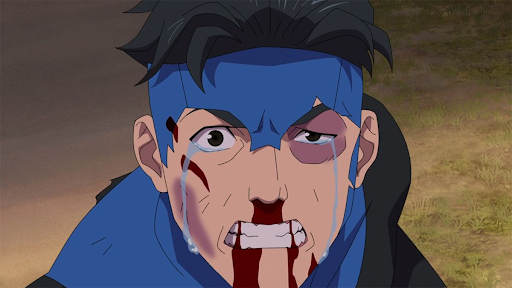
In the years since the initial release of Amazon’s “Invincible” in 2021, the gritty superhero epic has carved itself an undeniable spot in pop culture with both critical and commercial success and its constant presence in outside media, be it Omni-Man’s appearance in “Mortal Kombat” or the never-ending influx of memes stemming from the show’s most dramatic sequences. Although a lot of weight was placed on the shoulders of season three by comic book and TV show fans alike, “Invincible” delivers in spades with its best season yet. It continues to leave viewers shocked by how the show’s writers push its titular character.
Like its first season, the show’s third television run begins on a deceptively hopeful note. Mark Grayson (Steven Yeun) is the least vincible he’s ever been, with his strength and speed increasing exponentially since we last saw him in season two. He is in a blooming relationship with fellow superhero Atom Eve (Gillian Jacobs) and is mentoring his newly superpowered brother, Oliver (Christian Convery)—the way he wishes his father would have done for him—while still being there to save the world every day. His mother, Debbie (Sandra Oh), has a new boyfriend named Paul (Cliff Curtis), a well-meaning real-estate agent who tries his hardest to relate to Debbie’s earth-saving alien children. All seems well until we are again reminded of this show’s true nature, a realization that grows more bitter as we grow more attached to these characters.
Season three is brutal, to say the least. Although the show has never shied away from reminding viewers that this is no standard superhero fairy tale, with its abundance of graphic violence and depressingly tragic characters, season three of “Invincible” cranks the intensity up to 11. It unabashedly shows that the world these characters inhabit is the single worst fictional universe to live in, superpowers or not. This is displayed best by the turmoil of Mark Grayson himself, whose traumatic experiences in this season will make those watching want to take back any childhood wishes to be Superman and thank their lucky stars that the Viltrumites aren’t real (or at least that they haven’t visited us yet).
Despite its genre as a gory superhero cartoon, the narrative of “Invincible” is kept afloat by its humanity. Each character is nuanced and flawed, and people react to the show’s grave events in the most realistic way I have ever seen in a superhero story. Mark Grayson is an especially sympathetic character because he represents what most of us like to think we would be if we had superpowers; however, many people may change their view after witnessing the true burden of being Earth’s strongest hero. “Invincible” is without a doubt the most lifelike depiction of what it would be like to have these godlike figures in our world (yes, more than “The Boys” and “Watchmen”), and seeing how power enables these normal people to enact their wills provides an interesting look at human nature as a whole.
A significant portion of this season is devoted to questioning Mark’s idealist views of what it means to be a hero and showing how his opinions clash with the more pragmatic approach taken by his boss, Cecil Stedman (Walton Goggins). Additionally, his beliefs are challenged constantly by his brother, who, despite Mark and his mother’s best efforts, strongly believes that some villains should be killed so they can’t hurt anybody else. Since the end of the show’s second season, Mark has been wrestling with this ethical question himself. The decision he makes at the end of this arc and its possible consequences will have viewers excited to see how it manifests in the show’s next season. Finally, the third challenger to Mark’s beliefs is Powerplex (Aaron Paul), who blames him for the destruction in Chicago that killed his sister and niece in season one and demands revenge.
Without getting into spoilers, the final two episodes of season three are undoubtedly the most epic in the series. The episode seven features an unimaginable threat of ginormous scale brought by a figure once thought to be dead, and episode eight has a long, “Dragon Ball Z”-esque fight with easily the strongest villain we have ever seen in this show that ends in the most raw and brutal way imaginable. The show’s animators pulled no punches with these sequences, and this is especially impressive when considering the show’s small budget and short development time. This is not to say that there are no problems with the animation—these are certainly present at times, especially in the last two seasons. However, moments like these in the final two episodes prove that the blame for this should be placed on the corner-cutting of Amazon higher-ups and not on this talented team of artists, who received an unjust amount of hate for this.
The third season of “Invincible” is a more than worthy addition to one of the biggest shows of the decade. Regardless of whether you’re lucky enough to have remained unscathed by spoilers, I strongly recommend giving it a shot as it continues to prove itself as one of the standout pieces of media from this generation.
Elijah Willner can be reached at ewillner@wesleyan.edu.


Leave a Reply